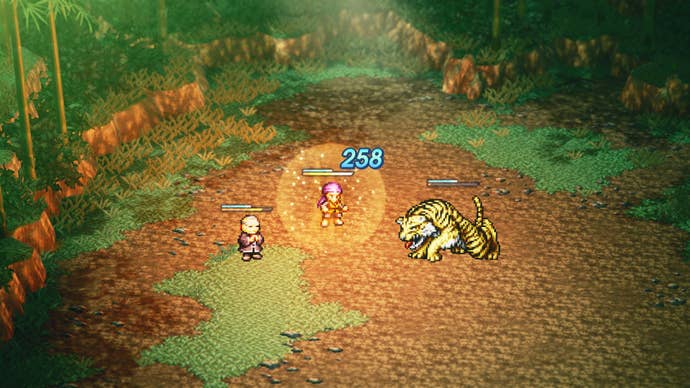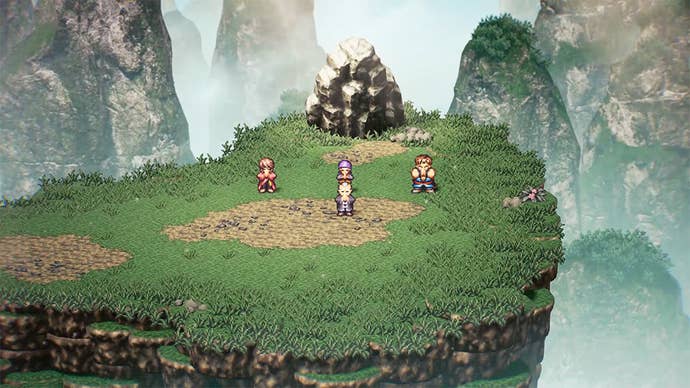Live A Live is a must-play 16-bit era classic, lovingly remade
In the 90s, Live A Live was outshone by its peers and missed a Western release. This excellent 2D-HD remake is a chance to set the record straight.
In the 90s, Square released two genre-defining role-playing games for the Super Nintendo: Final Fantasy VI and Chrono Trigger. But what if I told you that the prestigious studio didn’t just make two games of such quality? There is a third. Enter Live A Live.
Never heard of it? Well, that’s not all that surprising – Live A Live is a 1994 release that actually only released in Japan. It wasn’t from a famous franchise, didn’t even sell all that well even in Japan, and doesn’t have the art of Dragon Ball’s Akira Toriyama. So it just went sort of largely forgotten for years, except by the most despicable and dedicated of JRPG nerds.
Those nerds – including Undertale creator Toby Fox – did a good job of keeping Live A Live in the public consciousness over the years. Its status as a quiet cult classic appears to have helped Square Enix remember its existence. And so now, almost thirty years later, the game is making a return on Switch with a lavish Nintendo-published remake in the HD-2D style popularized by Octopath Traveler and Triangle Strategy. It’s just the latest release in what is proving to be something of a new RPG golden age for Nintendo.
Let me just address those who are already convinced of their interest in Live A Live up top: this is a good remake. It keeps the changes to a bare minimum, but adds voice acting, beautiful environments and characters that use a mixture of 3D and 2D pixel art assets, a variety of smart quality-of-life additions and tweaks, and a soundtrack rearranged beautifully by original composer Yoko Shimomura. Square Enix nailed the HD-2D look in its first run out, but having had a few more games to perfect it, the style really appears to be completely nailed-on now. I’m impressed with the quality of the remake – but I’m more impressed with the original game, even as someone who played it back in the day and has advocated for its importance regularly since.
Live A Live differs from its peers thanks to one clever core concept: rather than one long, sprawling RPG story, Live A Live features several shorter tales. Stretching from the prehistoric age into the far-flung future, you’ll experience a variety of different stories as a variety of different characters – each self-enclosed as its own little narrative, but also broadly connected to one overarching plot that’ll become clearer the more that you play. Each scenario’s lead characters were designed by a different famed manga artist of the time.

The beauty of these scenarios is that each is truly different. Live A Live has a basic framework in the sense of the way battles work (an interesting mix that uses a tactical RPG style battle grid with more traditional turn-based combat, albeit with moves that have varied charge times) and in terms of how the story is presented – but each scenario has its own gimmicks and presentational quirks to make it unique.
Some last under an hour, for instance, while others are mini-Japanese RPGs in their own right. One scenario does away with traditional leveling up; others require some light grinding, as is genre-tradition. Some feature random encounters, while some may only have you enter combat a handful of times, only for story-mandated combat encounters. There are, naturally, occasional unique combat wrinkles per-scenario – ranged gunslinging moves in the Wild West are naturally going to be quite different to the Kung-Fu battles in Imperial China, for instance.
These differences even creep their way into the presentation. In the prehistoric chapter, language has yet to be developed – so the story is told without dialogue either voiced or written. Instead, characters communicate through exaggerated sprite art gestures and speech bubbles featuring cave drawing-like pictures that aim to get an emotion or point across.
The first seven of these scenarios can be tackled in any order you like, while a final two await you once you complete them all. As you’d expect, the finale draws together all of the heroes from across history for one final showdown – but I’ll leave the rest for you to discover for yourself.

I love all of this. Not only is it an inspired way to visit a wide variety of settings and characters with JRPG trappings without the baggage of making hundreds of hours worth of content, but it’s also just fun to world hop. Even though the connections are tenuous, even without them Live A Live would work as a sort of weird little RPG anthology. This is all said before considering Live A Live’s greater cultural context, too: that director Takahashi Tokita went from this 1994 time period-hopping RPG to another, to work as one of a trio of directors on Chrono Trigger, the greatest Japanese RPG of all time – which also happens to be about multiple timelines, albeit in a more standard narrative for the time.
In a historical sense, I’d argue that to some degree Chrono Trigger is descended from Final Fantasy 6 and Live A Live. Both of those games were made at the same time, at which point teams shuffled and merged and the directors of those two games came together to work on Crono’s time traveling adventure. Anyway, that’s enough history, but suffice it to say I feel that Live A Live is a really important little piece of Square history, a vital game from one of the company’s most creatively fertile periods.

So you take this little classic, remake it in a loving, lavish way, and it feels only natural you get what feels like a new-old classic. For western gamers who didn’t play it in Japanese or seek out a fan translation, it has another unique quality, as it feels like a game of its era, like you’ve time traveled and are discovering something old and beautiful. It feels like taking your floorboards up and discovering a Roman mosaic, or something.
One thing I particularly like is that, as a modern localization of a 16-bit game, Live A Live is surprisingly spicy. The narrative dabbles in some harder themes, but it also isn’t afraid to just be a bit crass and silly. In the Wild West chapter, your protagonist is given a glass of milk at the bar. If you refuse it, an angry varmint declares “it’s not that you hate the milk, but that you can’t stomach it ‘less it’s from your mother’s t*ts!” As the player, you can choose how to respond, including with “Your mother’s, maybe.” All of this is voice acted, which enhances it, but it also represents the sort of thing that would’ve been sanitized out of the Western version back in the 90s. Today, we get a more natural Live A Live, with the sort of localization a game like this deserves.
The combat doesn’t quite have the depth of longer, more heavy RPGs of the time, but it’s also fed to you in such a piecemeal fashion that nor is such depth required. What really makes the combat work is the grid-based system, and the manner in which you must time moves in order to satisfy their charge requirements without having your action interrupted by a faster enemy. This gives a lot of battles, especially the story-critical ones, a puzzle-like feel which I really enjoy. Many of the ideas of games of this era have been heavily mined since, but Live A Live’s combat still stands as quite unique.

There’s caveats, of course. Live A Live is on the short side for a game of this type, owing to the way the narrative is structured – though there are optional super-bosses and other incentives to replay some of the story chapters. The final story chapter that brings the leads together has the potential to be something truly special, but lacks the punch or the interactions between the characters you’ve got to know separately to really work as it should. Even in this remastered form it’s still generally too easy, as previously noted – but the pure originality and ambition on show makes it a wonderful time capsule nevertheless.
I want to be clear. These caveats and other elements of the game combine to mean that, no, Live A Live isn’t quite as good as either Final Fantasy 6 or Chrono Trigger. Even with that said, however, it does feel like it belongs alongside them. It feels monumentally important, wonderfully clever, and full of a gleeful energy that’ll make the heart of any old-school RPG fan swell. Top marks on this website doesn’t mean it’s a perfect game; it just means we recommend playing it absolutely unreservedly – and such is the case here.
Live A Live launches on July 22 for Nintendo Switch.


